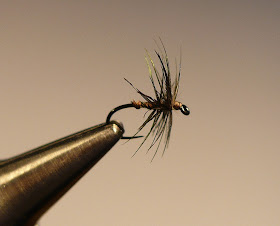The Black Spider
I've been fascinated by the starlings neck feather for quite some time. While reading older books about fly fishing it's inevitable to stumble patterns including this very feather. The Black Spider made known by W. C. Stewart in his book "The Perfect Angler", is a beautiful creation just to look at. The thin green sparkling barbs gives a very distinct illusion of life, being used on a dry fly or as in this case a spider. The fly above is tied like Stewart did, winding the feather together with the brown silk thread backwards which makes it pretty durable. I remember from Stewart's book that he mentions that this fly is somewhat overdressed but that it will be perfect after catching a dozen trout on it (might be wrong about the exact number but I think you catch my drift anyway). It certainly seems that the trout were more numerous at that time. I'm more than happy to take one trout to hand.
How many of us haven't started out using flies that are so overdressed that the material used would be sufficient for five flies? In one of his books Vincent Marinaro wrote something like that about flies in the tackle stores. But after having caught a number of trout, that have chewed away some of the material, the flies become more efficient, why? I think that the answer is that they have become more lifelike; giving an illusion of life since the hook isn't any longer stuffed with material so it becomes almost static. I think that is the reason that CDC-flies are constantly gaining ground as a material used to tie flies. The material in itself is almost a living matter. I've been using flymphs as if they were regular dry flies and it seems to me that the trout take them with the utmost confidence that it's a food item. So in my opinion it's well worth taking into account to what degree our flies have an illusion of life that might trigger the spookiest of trout to take the fly. Well thats about it for now so until next post ...
Friendly greetings,
Mats Olsson
How many of us haven't started out using flies that are so overdressed that the material used would be sufficient for five flies? In one of his books Vincent Marinaro wrote something like that about flies in the tackle stores. But after having caught a number of trout, that have chewed away some of the material, the flies become more efficient, why? I think that the answer is that they have become more lifelike; giving an illusion of life since the hook isn't any longer stuffed with material so it becomes almost static. I think that is the reason that CDC-flies are constantly gaining ground as a material used to tie flies. The material in itself is almost a living matter. I've been using flymphs as if they were regular dry flies and it seems to me that the trout take them with the utmost confidence that it's a food item. So in my opinion it's well worth taking into account to what degree our flies have an illusion of life that might trigger the spookiest of trout to take the fly. Well thats about it for now so until next post ...
Friendly greetings,
Mats Olsson
CLICK ON THE IMAGE TO ENLARGE

I have a few in my box, they were given to me by Mark. Perhaps I should fish them.
SvaraRaderaHi Alan!
SvaraRaderaI certainly think so! In very calm water they still give an impression of life that triggers trout to take them. Thanks for stopping by and give a comment!
A great pattern - hangs around in the surface film for that touch longer than normal spiders. Interesting article, thanks.
SvaraRaderaM
Hi Matthew!
SvaraRaderaThanks for stopping by and commenting! I like spiders very much and other patterns that has survived for a long time. Just imagine how many trout has been caught on a pattern that might have been around for like a couple of hundred years and is still used. This fly really has a rich heritage.